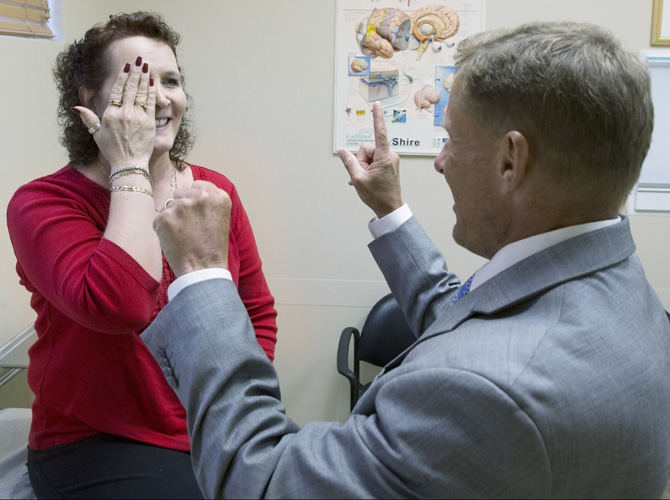A certain aura sweeps over Christine Perkins and with that, an urgency to retreat to a dark, cool, quiet room to lie down with a cold compress on her head.
The 53-year-old Vero Beach woman has suffered migraines since her early teens. These have interrupted outings at restaurants, parties and daily activities, and presented a steep learning curve not only to her but to family and friends. They’ve required lifestyle changes and medications to help her manage.
They’ve also sent her to bed for an entire day, several days a month.
“It feels like my head is in a vice,” she said. “It makes you sometimes willing to do anything to make it stop.”
Migraines are a highly prevalent disorder. Some 30 million people suffer from migraines; 21 million of those are women. Roughly 1 in every 4 households has a migraine sufferer, and the condition is more common than diabetes and asthma put together. People who suffer them tend to between the ages of 25 and 55.
A migraine tends to begin as a dull ache, then develops into a constant throbbing and pulsating pain that you may feel at the temples, as well as the front or back of one or both sides of the head. The pain is usually accompanied by some combination of nausea, vomiting, and sensitivity to light and noise.
Some people experience an aura – a manifestation of neurological symptoms –before a migraine headache. There may be wavy or jagged lines, dots, or flashing lights; or a person might experience tunnel vision or blind spots in one or both eyes. The aura can include visual or auditory hallucinations and disruptions in smell (such as strange odors), taste, or touch. About 15-20 percent of migraine sufferers get an aura.
For Perkins, the aura tends to be an odor or taste, then the driving headache sets in.
“It’s been four decades,” she laments. “It’s not been fun. As someone with the illness you learn to adjust and adapt. You don’t let them beat you or define you.”
Perkins attributes medication, education and lifestyle changes for making all of the difference in her ability to cope with 12 to 16 migraines a month.
The cause of migraines is believed to be chemical reactions in the brain. Treatment for migraines may include over-the-counter or prescription medications, as well as self-help techniques such as relaxation training and biofeedback.
The physical and environmental triggers for migraines are all over the map. Hormonal causes are associated with the menstrual cycle – before, during or after. Red wine can set one off. So can chocolate, milk, aged cheeses like blue cheese and cheddar, monosodium glutamate, aspartame, drastic changes in barometric pressure, colognes, perfumes and certain cleaning products.
“You have to have a supportive family,” she said. “My family and friends have had to learn, along with me. I had to have my teenage boys put on their cologne outside – you know teenage boys like to have people smell them 50 feet away.”
The smell of cleaning products can trigger migraines for her, so Perkins cleans her house with vinegar and baking soda or other green products. And she will take a pass on chocolate desserts. “It’s never worth how I’ll be feeling.”
Dr. S. James Shafer, board certified neurologist with Vero Neurology, says 20 percent of his practice is made up of migraine sufferers.
“There are societal burdens of headaches,” he said. “Migraines impact people severely – they miss social events, don’t plan things and become social hermits. They often have a hard time taking care of the house and kids, or miss work.”
Perkins takes Imitrex when she feels a migraines coming on – that is, when she gets flashes of light in her eyes, her cheek or bottom lip begin to tingle or pressure builds up behind her right ear. The medication has helped cut the migraine experience down considerably.
Most people suffer from more than one of the many types of headache: stress induced, cluster, tension, sinus and rebound. When diagnosing the problem, Shafer reviews their social surroundings and habits, including diet, sleep patterns and whether they smoke.
Women are particularly susceptible to migraines when their hormone levels are unbalanced – during menstruation, pregnancy, or menopause. In fact, about three quarters of women with migraines report that their attacks are related to the menstrual cycle.
Shafer said treating people with migraines has come a long way over the decades. There are a lot of great medications such as triptans that work within an hour so that migraine sufferers can keep on doing what they are doing.
More than just a bad headache, migraine is a complex neurological condition involving overstimulation of pain receptors, sensitization of parts of the brainstem, inflammation, and dilation of blood vessels.
One promising area of migraine research is focused on the receptors in the brain and how to manipulate them to block migraines altogether or reduce them.
“Migraine treatment has improved dramatically in the last 10 years,” said Dr. Fernando Miranda, a Vero Beach neurologist. The anti-seizure drug Topamax, for one, can often take care of the headache in 20 to 30 minutes.
But bad headaches that persist can be a red flag – a reason to get an MRI to rule out something worse.
Many people ride out their occasional migraines and get back to life without needing a doctor or special drugs. But for those hit hard, there are options.

